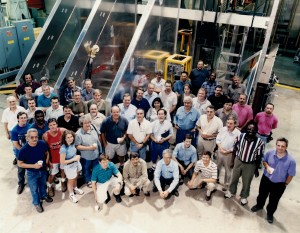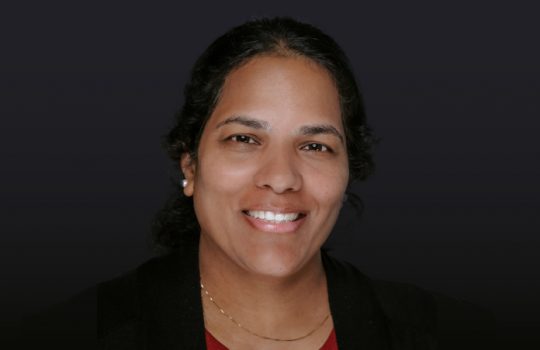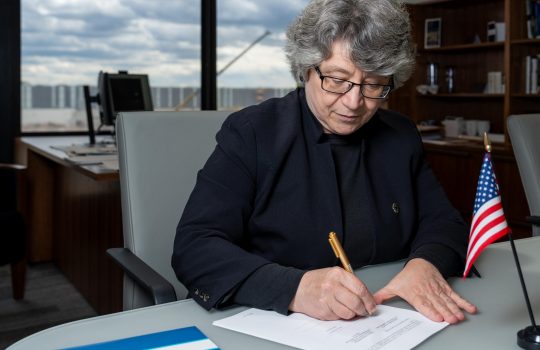
On Aug. 25, 2000, the DZero collaboration team completed construction on the forward muon system detectors. Designing and building the detector took approximately five years with the help of scientists, engineers and technicians from Fermilab, JINR and other Russian institutions. Photo: Fermilab
Near the end of the competitive Space Race in the early 1970s, a Soviet institution joined forces with a young Fermi National Accelerator Laboratory to work toward a greater understanding of the subatomic world. The Joint Institute for Nuclear Research in Dubna, Russia, which celebrated its 60th anniversary on March 26, remains an important, long-running Fermilab collaborator.
This relationship began in 1972 when JINR sent some of the first Soviet scientists to Fermilab. Together, American and Soviet scientists worked at the lab’s first accelerator system, using a Soviet-built jet hydrogen target in the proton beam.
“After this initial collaboration, there were quite a few scientists traveling between the United States and the Soviet Union,” said Dmitri Denisov, co-spokesperson on the DZero experiment and head of Fermilab’s Particle Physics Initiatives Department. “There were many labs in the USSR active in accelerator-based particle physics and using high-energy accelerators that resembled the science at Fermilab.”
Soviet scientists from multiple institutions soon noticed the similarities between the USSR and U.S. experiments as well as interesting, mutual scientific goals. In spite of the tension between the two nations, Fermilab became one of the few places in the U.S. for Soviet scientists testing their prototypes, conducting R&D projects and performing sophisticated, long-term experiments, Denisov said. This collaboration became a symbol of two competing countries overcoming their differences and working together to move the field of particle physics forward.
By the late 1980s and into the 1990s, CDF and DZero became a major focus at Fermilab for Russian particle physicists. At that time, Denisov was a young graduate student and worked with the Institute for High Energy Physics in Protvino, a small city near Moscow. He, along with a few other colleagues, joined the DZero experiment.
“We were all eager to come here, and about one or two years later, we planned to go back and construct a similar, even larger experiment in the USSR,” he said. “But the situation became difficult as the USSR disintegrated in 1991.”
Russian particle physics experimentation slowed down, and many projects ended. One option was to come to Fermilab and keep up with the ongoing experiments here. Although there were very few of them at the time, Russian scientists at Fermilab contributed to the discovery of the top quark. Soon after the discovery, more scientists came to the lab to work with other collaborators, upgrading the DZero detector or joining the CDF experiment.
Experiments at the Tevatron, which was the world’s highest-energy collider in the early 2000s, was the peak of Russian collaboration at Fermilab and provided a great opportunity to plan for future projects with Russia. By about 2005, a total of almost 300 scientists and engineers from Russian laboratories and universities joined Fermilab in several experiments. At the end of the Tevatron run, a couple of years later, many Russian scientists and engineers joined projects such as NOvA and Mu2e.
In early 2014, as the crisis in Ukraine unfolded, U.S. and Russian relations grew fragile, and additional approvals were necessary for Russian users and visiting scientists visiting Fermilab.
Aleksandr Simonenko, a contributing scientist from JINR, used to visit Fermilab for six months out of the year in 2007 for the CDF experiment. Simonenko now visits Fermilab for almost three months out of the year for the Mu2e experiment. Russian institutions continue to send their scientists to Fermilab to work on experiments such as CDF, DZero, Muon g-2, Mu2e and NOvA.
Last year, 75 scientists from 10 collaborating Russian institutions and laboratories worked at Fermilab.
“I think all scientists should participate in collaborations like this one, because each time you come, you get some additional experience and learn about the work of other places,” Simonenko said.
With the proposed international DUNE experiment, Fermilab may be able to further boost Russian participation.
“We must think of our work as science without borders,” Denisov said. “Science doesn’t depend on politics that much, but it’s beneficial to exchange our cultures and views. Science brings us together, and it is the same here just as it is in Russia. That’s why we work well together.”



